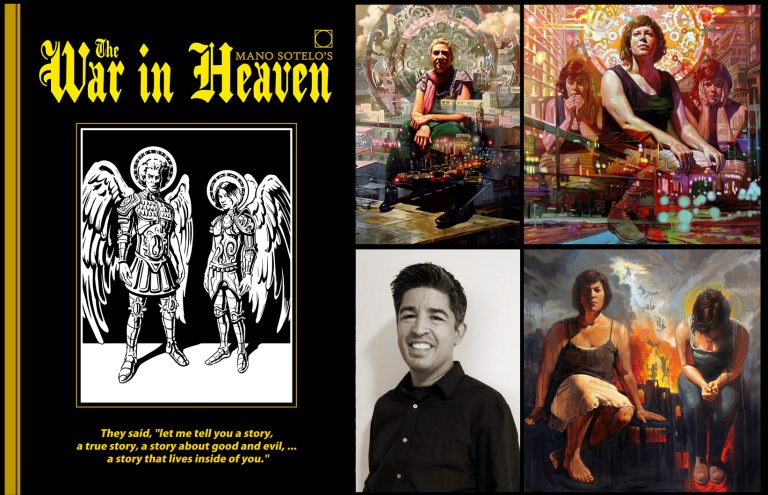
Drawing the Soul: How Art Can Be a Path to Self-Realization and Spiritual Awareness
By Mano Sotelo
Throughout human history, visual art has served not only to beautify and communicate, but also to guide us inward. When approached with intention, the creative process—whether through drawing, painting, or visual storytelling—can become a contemplative practice, offering healing, transformation, and a path toward self-realization and spiritual growth for both artist and viewer.
Art as Psychological Development
Unlike language, visual expression is not bound by rules of grammar, syntax, or word order. For this reason, creating an image of emotions or abstract concepts—like love, fear, or grief—is often easier than articulating them in words. This is central to art therapy, which views creative practice as a means of accessing the unconscious, expressing complex inner states, and supporting psychological healing. Once the artwork is complete, engaging with it non-judgmentally can open space for insight, discovery, and meaningful dialogue.
By creating from an introspective lens, artists may begin with consciously framed questions: What do I think about this topic? What do I value? How do I feel? Who am I? The resulting images become visual responses—less about emotional release and more about symbolic thought. These externalized dialogues help articulate inner reasoning and invite critical reflection. In this way, the act of art-making becomes a tool for examining one’s perspective, clarifying beliefs, and probing the boundaries between perception and truth.
In my own practice, I’ve found that drawing from the imagination—making mental images visible—can bring unconscious beliefs and emotions to the surface. While working on a panel of two figures for The War in Heaven, I gradually realized the tension between them mirrored a personal inner conflict I hadn’t intended to depict. What began as a simple illustrative choice became a doorway to emotional insight. With careful attention, the artwork itself becomes a mirror—one that reflects not only emotional content but deeper layers of identity and personal history. As art therapist Cathy Malchiodi writes, “Art therapy is not about learning to draw or paint, but about learning to see” (Malchiodi 15).
Drawing as Devotion: Art as Contemplative Prayer
Beyond psychological insight, art can also serve as a spiritual practice. In the solitude of the studio, drawing from observation can foster mindfulness, while rendering symbolic forms becomes a mode of prayer. In this sense, the studio becomes a kind of sanctuary.
Traditions around the world have long used visual symbols—icons, mandalas, sacred geometry—to cultivate spiritual awareness. Across cultures, there is a rich history of creating images of the divine as a means of reflection, reverence, and communion with the sacred. When the creative process is approached with humility, presence, and openness to mystery, the artist does not simply depict—they seek.
How does one go about depicting God—or the divine? In my graphic novel The War in Heaven, I explored the struggle between opposing spiritual forces: good and bad spirits, archetypes of divinity found across both Eastern and Western traditions. Each panel became a way to symbolically render unseen dynamics—not only within the narrative, but within myself and the wider human experience. What began as visual storytelling often evolved into contemplative practice. The long hours of drawing became moments of quiet meditation, gradually deepening my connection to both the sacred and the psychological.
Creating Meaning for Artist and Viewer
Art invites both artist and audience into deeper awareness. When artists share work rooted in inner searching or spiritual inquiry, they extend that invitation to others. The image becomes a vessel for contemplation—a visual form through which viewers may glimpse something beyond themselves.
As I wrote in a recent reflection, when the creative process is shaped by observation, contemplation, meditation, or prayer, “the resulting artwork becomes more than a product—it becomes a reflection of the sacred world” (Sotelo).
By embracing art-making as both psychological excavation and spiritual devotion, we begin to see not only who we are, but also our relationship to the world around us. Making art becomes a way to access the present moment, ultimately creating a path that leads to artwork reflecting both ourselves and the divine.
Works Cited
Malchiodi, Cathy A. The Art Therapy Sourcebook. McGraw-Hill, 2007.
Sotelo, Mano. “Observation, Contemplation, Meditation, and Prayer Through the Creation of Art.” Sotelo Studio, 1 Jan. 2024, www.sotelostudio.com/post/observation-contemplation-meditation-and-prayer-through-the-creation-of-art.
About the Author
Mano Sotelo, BFA, MFA, MBA, is an Arizona-based artist, author, and educator. His graphic novel The War in Heaven serves as a visual allegory of belief, conflict, and the search for inner peace. Mano has presented his creative work at conferences held at Harvard Divinity School, the University of Oxford, and Sapienza University of Rome. His art has been exhibited in museums such as the Alexandria Museum of Art, Tampa Museum of Art, and Coos Art Museum, and recognized by The Artist’s Magazine and International Artist Magazine. Learn more at www.sotelostudio.com.